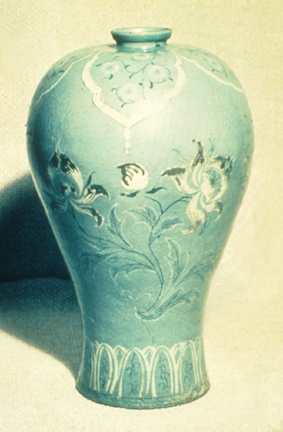
Koryo Dynasty Meiping with Blue Celadon Glaze
Korea, 900-1000 CE
ART 198 - HISTORY OF WORLD CERAMICS
| The most famous of the pottery of Korea are the celadons of the Koryo Dynasty (935 - 1392 CE). Influenced by the contemporary potters of Song Dynasty China in form and technique, yet uniquely Korean in surface design. Here the familiar meiping (plum blossom vase) gets a new kind of surface treatment. The technique is called sanggam by the Koreans, and mishima by the Japanese, who later were to copy it. Sanggam is simply an inlay technique. At the leatherhard working stage, designs are carved and/or stamped into the firm surface. Next slips of contrasting colors to the clay body are painted into the depressed areas made by carving and stamping. Here a white and and dark brown slip were painted into the carved design. The clay body is a light gray color. After the applied slip dries to the touch, it is scraped or sanded off until it is only left in the depressed areas. Now the design is clearly visible in contrast to the clay body. Next a celadon glaze is applied and the piece is fired in a closed, chambered kiln of Chinese design, and after firing, the pattern is visible through the pale blue celadon glaze. The flower used in this design is the peony, associated with springtime and royalty. Due to minor differences in the chemical composition of the clays and feldspars used by Korean potters, the celadons of Korea are often this pale blue green rather than the gray green celadons seen in China. | Koryo Dynasty Meiping with Blue Celadon Glaze Korea, 900-1000 CE |
|
|